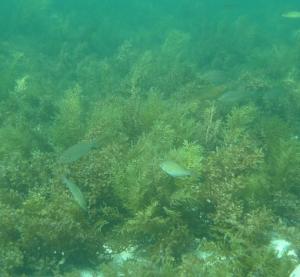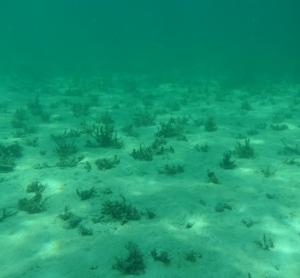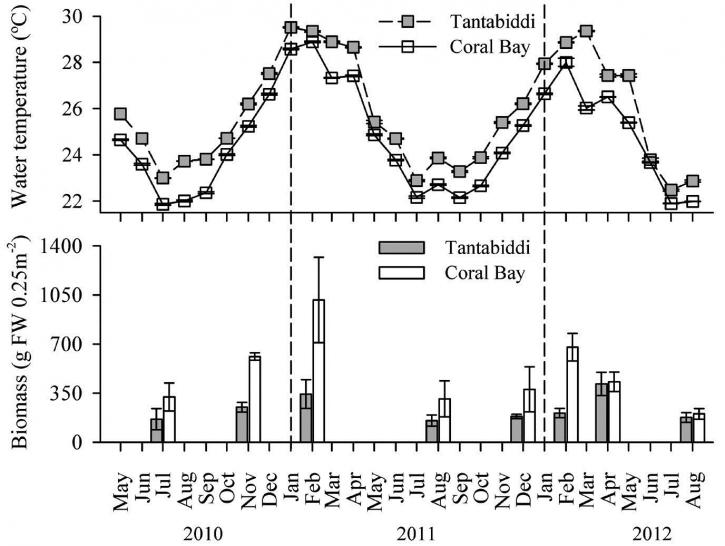Home > Biology and biodiversity > Coral reefs > Macroalgae > Sea temperature drives seasonal cycles in Ningaloo seaweed meadows
Sea temperature drives seasonal cycles in Ningaloo seaweed meadows
- Ben Radford
- Australian National University ,
- Australian Institute of Marine Science,
- Department of Parks and Wildlife
Dr. Chris Fulton (Research School of Biology, The Australian National University), Dr. Martial Depczynski & Dr. Ben Radford (Australian Institute of Marine Science), Dr. Shaun Wilson (Department of Parks & Wildlife WA)
Background
Marine ecosystems comprise a mosaic of habitat types that provide food and shelter for a huge diversity of plants and animals. One of the most prominent habitat types along the tropical coast of Western Australia are seaweed meadows, created by the growth of large fleshy seaweeds such as Sargassum. In these seaweed meadows we often find species that are found nowhere else, or the juveniles of fishes that as adult live in other habitats such as corals or sponges. Many of these seaweed-associated fishes are important targets for fishing (e.g., Spangled emperors) or maintain key processes such as herbivory (e.g., Marbled parrotfish).
Ningaloo has an extensive network of seaweed meadows that cover up to half the total area of the lagoon. Many visitors to Ningaloo have noticed large amounts of seaweed washing ashore at certain times of the year (often during March-July), which is the result of Sargassum breaking away from the nearby seaweed meadows (Figure 1). Given these seaweed meadows are an important habitat for many other species, we need to understand how and why these seaweed breakage events occur. In this research project we measured the amount of seaweed (biomass) present in meadows at two locations (Tantabiddi and Coral Bay) within the Ningaloo lagoon over the summer (February), autumn (April), winter (August) and spring (November) for two years and explored whether changes in seaweed were linked to seasonal shifts in climate (sea temperature, wind direction and strength, wave heights, light, rainfall).


Figure 1.Seasonal changes in Ningaloo seaweed meadows from summer (left) to winter (right). Photos: Chris Fulton.
Research Findings
· Peaks in seaweed biomass tend to occur within the meadows during late summer (around February each year), most of which is Sargassum (Figure 2);
· Changes in Sargassum biomass within lagoonal meadows at Ningaloo are closely linked to seasonal changes in sea surface temperature (Figure 2);
· Major changes Sargassum biomass occur 1-month after changes in sea temperature;
· Seaweed meadows can lose much (up to 94%) of their seaweed biomass each autumn-winter, although some meadows lose relatively little (as low as 12%) each year;
· New seaweed canopies regrow each year from the same “root” bases that persist through winter (see right panel of Figure 1), which means each seaweed individual may be quite old and important for maintaining these seaweed meadows through time;
· Seaweed meadows lose an average of 15 tonnes in biomass per hectare over each summer-winter cycle; and
· Current estimates suggest seaweed meadows cover 2,000 hectares throughout the Ningaloo lagoon, hence seaweed meadows are injecting around 30,000 tonnes of primary production into the Ningaloo ecosystem each year.

Figure 2.Changes in seaweed biomass within lagoonal meadows near Tantabiddi and Coral Bay (bar chart, bottom panel) at Ningaloo are closely linked to seasonal changes in surrounding sea temperature (line chart, top panel) over two years (2010-2012). Extract from Fulton et al. (2014).
Management Implications
Seaweeds cover extensive areas of the benthos in DPaW managed marine parks, are major primary producers, and provide habitat and food for numerous fish and invertebrate species. Understanding the processes that govern changes in seaweed abundance over space and time provides a basis for assessing the risk of losing this important habitat, and determining what sort of management may be appropriate for their protection. From this research, we now know that Seaweed meadows at Ningaloo can change dramatically as a result of natural seasonal changes in sea temperature. The normal growth-decay cycles of these seaweeds produce a large turnover in primary production (i.e. amount of biomass produced by photosynthesis) each year, which provides food and energy for a wealth of other species that make up the unique World Heritage Ningaloo ecosystem. The strong link between seaweed biomass and temperature also suggests that changes in sea temperatures will influence when and where seaweeds are most prevalent throughout Ningaloo. While some seaweed meadows underwent major losses of seaweed cover over summer to winter, other meadows retained a high amount of seaweed year-round, which suggests that: (1) we need to protect a large number of seaweed meadows to encompass the broad diversity of changes they experience across space and time, and (2) some seaweed meadows may require additional protection as critical habitat refuges for the many fish, and invertebrate species that depend upon them for food and/or shelter throughout summer and winter seasons.
More Information
Fulton CJ, Depczynski M, Holmes TH, Noble MM, Radford B, Wernberg TH, Wilson SK (2014) Sea temperature shapes seasonal fluctuations in seaweed biomass within the Ningaloo coral reef ecosystem. Limnology & Oceanography 59, 156-166.







